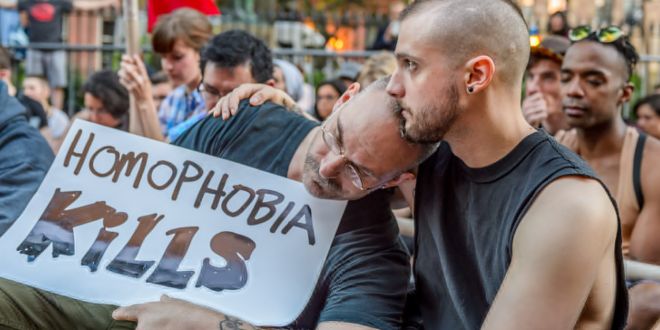Are men and women with gender issues required to deal with those issues effecting gays and lesbians? Yes, absolutely. There are many issues existing that effect both transgender persons and gays and lesbians. The most insidious and device of which is homophobia. Homophobia is an irrational fear or dislike of gays and lesbians. Moreover, it is an intense misunderstanding of who gays and lesbians are, based on stereotypes, misinformation and ignorance.
At times homophobia is acted out in open discrimination, harassment and violence. Homophobia is however, more commonly acted out in a less direct fashion, in such a matter that does not actually victimize another person, but leaves the person acting it out not feeling very healthy or balanced. Subtle, indirect and passive-aggressive types of homophobia is something that comes from within a person. It may not always be directly expressed, but it is felt.
Anger and fear is the most obvious root of homophobia, this would also include transgender persons. Are transgendered individuals so emotionally brittle that they would act on a homophobic impulse? You bet! Many transgender person are madder than hell that society has stomped on them, and they fully intend to make others pay. The most common way one victimized party supposedly makes itself feel more validated is to put others down. Others don’t act it out, but they definitely feel it.
The more subtle, underlying dynamic which makes both direct and indirect homophobia possible are differences between people. Transgender individuals are vastly different from gays and lesbians. We primarily deal with gender identity issues. Gays and lesbians, on the other hand, deal primarily with sexual orientation issues. Is there really that wide a canyon between gender identity and sexual orientation issues? Certainly. Read further for some thoughts to consider.
With the exception of gay or lesbian-identified transgender persons, most transgender persons typically spend a great deal of time impressing upon others that they are not gay or lesbian. To wit, cross-dressers frequently make a concerted effort to impress upon their spouses they are not interested in same-sex encounters. As well, transsexuals frequently must spend a great deal of time answering non-transgendered assumptions. You’re gay, right? No, I’m a transgender woman. Continuously responding to those types of questions can get very tiring for people who wish to keep personal lives private.
Direct incidents of transphobia (hatred and misunderstanding of transgender persons) can also feed homophobia. For example, although I have gay and lesbian friends and colleagues, I occasionally have found myself dealing with the preceding dynamic. I reside in progressive San Francisco, yet I’ve also personally encountered transphobia blatant enough to turn the warmest heart stone cold.
During the early 1980s when having a transgender identity was less accepted by gays and lesbians, there were a variety of occasions I was verbally harassed or physically attacked by these persons. How dare you make us gays look bad by living as a woman. You have to leave, this may be the Castro, but we don’t serve your type of person in this business. Words hurt, but so did the spit, rocks and bottles I had thrown at me by hostile gay men. Such attacks these days would not be considered politically correct, although I still hear of those situations occurring from time to time.
Naturally at the time I discussed the transphobia I experienced with those gays and lesbians I considered supportive. They assured me that not all gays and lesbians hated transgender people. Despite those consoling words a deep anger remained inside of me. I found that this anger came out often at the most inconvenient times. In the future, when I encounter petty acts of transphobia from gays or lesbians, I feel I would throw a big fit! Can you image a full grown therapist throwing temper tantrums in public? These feelings arise most frequently when I am minding my own business, and I encounter a gay couple who was not content to leave me alone.
Loudly and dramatically, one of such a couple would make an derogatory statement. Hey you over there…Miss Thang you ain’t fooling no one. These persons obviously had become accustomed to San Francisco’s freedoms for gays and lesbians, and believed that included harassing other minority groups. As a result of this I grew to resent seeing two gay men holding hands, or seeing a gay man who is putting on appearance of straightness at work in order to reap the riches of mingling unnoticed in a heterosexual environment. Seeing these people angered me, particularly while transgender persons were still struggling with basic human rights.
Over time I got really tired of feeling anger over these issues. I also recognized that others from our community often dealt with the same issue, just in different ways. I found myself asking a question. How would I advice a client dealing with a similar issue? My answer was pretty easy to understand. It is possible to hate a persons behavior, while still care that the person who victimizes others is also human. They are a human who is hurting, just like some of us do at times. They, in fact, may be hurting so bad they cannot see they are hurting others.
I have thought about this issue over the years. It doesn’t take a lot of energy for a complete stranger to harass another stranger. We are biologically predestined to immediately notice differences in others. Noticing differences warns of us impeding danger and potential hostility. During less sophisticated epochs, basic survival meant either running from or attacking anything that looked different. Regrettably, our civilized culture has not advanced that much, when one person will initiate a verbal attack in order to avoid being spotted as different him or herself.
For myself, I knew that disliking someone’s behavior was appropriate. I also knew that disliking a person because they are different was a natural reaction. However, it didn’t mean I needed to react without sophistication. I could go about my business, and when I saw different types of people I could wish them well as long as they left me alone. And, when harassed, rather than pointing out someone’s differentness, I could point out that their behavior was hurtful and wrong when they disrespected my space.
If after numerous years I am still examining such issues, I can imagine some of my readers are also. The best advice I have if someone harasses you, is to tell them to take that chaos down the street. Be assertive, don’t argue. Do not disrespect that person’s differences no matter how much you dislike their behavior.
Copyright 1998
by Gianna E. Israel
 Lesbian, Gay, Bisexual, Transgender & Intersex News Lesbian News, Gay News, Bisexual News, Transgender News, Intersex News, LGBTI News
Lesbian, Gay, Bisexual, Transgender & Intersex News Lesbian News, Gay News, Bisexual News, Transgender News, Intersex News, LGBTI News




